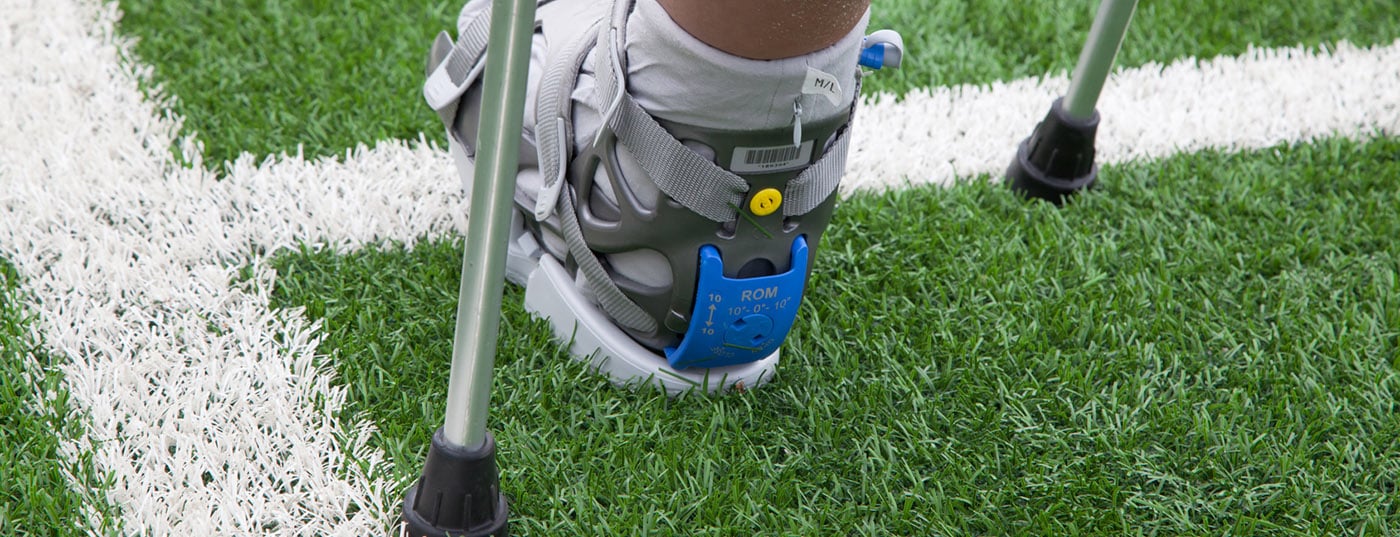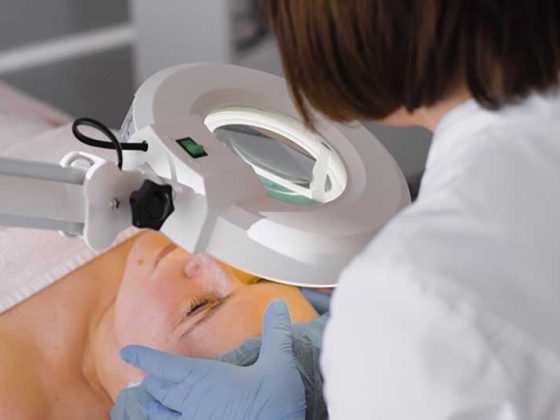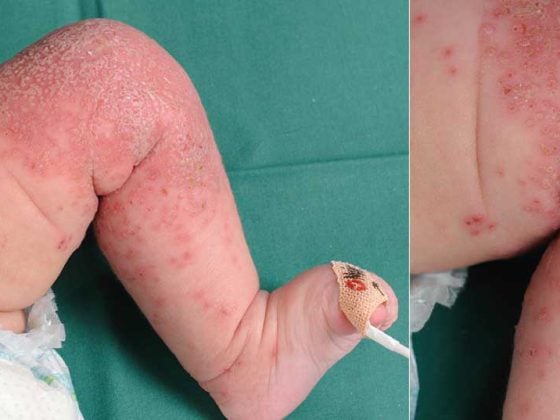After a serious sports injury, it is not uncommon for one of the first questions asked by the athlete to be the duration of the impending outage. The will to return to the previous level as quickly as possible is very strong in top athletes. In order to achieve this goal, constructive cooperation of all professionals involved in the acute initial treatment as well as in the further rehabilitation phase is required.
Return to Sport is a very common topic in current sports medicine. Often it is a question of which usually very strict rules of conduct can be used to make it possible to return to sporting activity (pre-competition training and competition) as quickly and safely as possible. From our point of view, however, the term should be understood more broadly, describing and commenting on all the measures necessary for the successful path from the accident to just this return to sporting activity and also possible physical changes.
Physical changes after sports injury
One process that begins quickly after a sports injury is the decline in conditioning factors. As Åstrand [1] demonstrated in a famous experiment more than 50 years ago, maximal oxygen uptake VO2maxdecreases by 50% within 20 days, while strength (according to Hettinger [2]) decreases by 25% within 14 days. Considering the time necessary to return to baseline – 60 days for endurance and even longer for strength – it is logical to begin replacement training as soon as possible after the injury. In most sports injuries, it is possible to at least consolidate these condition factors while sparing the injured body part. Here, physiotherapists in particular can let their imagination run wild and develop sport-specific forms of exercise.
When regular and intensive exercisers are suddenly forced – as just in the case of a more serious sports injury – to abruptly abandon their usual activity, they may be affected, much like addicts, by a phenomenon known in the specialized literature as acute offloading syndrome. The term unloading syndrome – also sports withdrawal syndrome – is used to describe health disorders that can occur when sudden unloading occurs. In the short term, abrupt discontinuation of competitive sports training can lead to this clinical clinical picture. Unloading syndrome usually begins 1-4 weeks after training is stopped, lasts up to several months, and is more common in endurance athletes than in (speed) strength athletes. Symptoms consist primarily of nonspecific cardiac-related complaints, such as arrhythmias felt as palpitations, cardiovascular lability, and dizziness, but may also take the form of digestive disturbances and sleep disturbances. Often there is an impairment of the subjective well-being with emotional instability up to depressive mood. The causes of these complaints are unclear; hormonal or central nervous mechanisms probably underlie them. For the prevention or treatment of acute unloading syndrome, systematic abtraining should be performed, i.e. reduced regular training should be continued or resumed. Endurance sports are the most recommended form of exercise.
Recently, there has been a discussion in the media about the field of sports as a form of addiction. A recent German study speaks of just under 5% at risk of sports addiction [3]. The basis of this addiction is similar to other addictions: the reward system in the body is constantly kept on its toes. The result is that a well-intentioned activity becomes the central focus of life. If this addiction can no longer be pursued due to injury, the sports withdrawal syndrome discussed above may result.
Doping in the context of sports injury
As (almost) always in sports medicine, attention should be drawn to the doping problem in this particular situation. The dramatic decline in condition factors, especially strength, at a certain point, could stimulate the temptation to counteract this extremely unfavorable development by means of pharmacological assistance. Anabolic steroids could be mentioned here as an example substance. It should not be forgotten that the anti-doping authorities retain the right to conduct (so-called out-of-competition) tests even during an outage. Thus, it could be fatal to disregard the applicable rules due to a violation, even from the medical side.
Therapy scheme and its pitfalls
A classically practiced therapy scheme represents the sequence: Diagnosis → treatment → rehabilitation → replacement training → return. The division of tasks between doctors, physiotherapists and trainers is not always very clear, and there is often an insufficient flow of information between the doctors involved (often several, e.g. sports doctor and surgeon). These constellations understandably lead to undesirable misunderstandings, complications and delays. It is therefore extremely important that one person acquires the central role of coordinator (ideally the sports physician).
A closer look at the above-mentioned therapy scheme reveals, at least theoretically, a gap at the end of classical medical care. When physical therapy is considered complete and the treating physician deems the situation compatible with sports, the affected athlete finds himself in a sort of therapeutic “no-man’s land,” often without further professional guidance. It is all too rare for coaches to be trained in this area, and specialized rehabilitation coaches are only found on staff in very professional sports structures. This unsatisfactory condition is most likely one of the main reasons of recurrences, which unfortunately are not rare in sports traumatology (up to 10%). Once again it becomes clear how important teamwork is in the discussed process. Under no circumstances should there be any tension between the different partners of the rehabilitation team, especially with the representatives of the sports side.
Also extremely important is that the whole process starts very quickly. Perhaps the most important aspect, but not discussed here for reasons of competence, is the psychological support of the athlete during the entire duration of this rehabilitation. Psychological trauma is not infrequently more severe, but more imperceptible than physical trauma. Whether a sports psychologist needs to be consulted should be evaluated on a case-by-case basis. The coordinator should not lose sight of this element from the beginning (motivation= key to success!).
Rehabilitation needs structure
Using the example of a structure that is very often seriously injured in sports – the anterior cruciate ligament (ACL) of the knee joint – a typical rehabilitation path can be demonstrated. An important question here is what are the criteria that indicate to the various caregivers that a successful return to the former competitive sporting life is possible. Often, instead of following a systematically developed plan, the “wrist × π” principle is used.
A typical procedure for ACL replacement surgery is as follows: After an average of six months, the operated joint is clinically unremarkable (no effusion, no irritation, subjective and objective stability, etc.), a phone call to the physiotherapist, questioning of the patient, who will almost always respond positively with impatience, and the green light is given. The patient returns to his daily sporting routine, the coach assumes that his player is ready – and off he goes! This is the moment when, by loading too early, the undesirable can happen, i.e., injury recurrence. Therefore, the process to make the final decision to be allowed to return to full athletic performance should absolutely be guided by clear criteria. To help, there are more and more assessment tools in this area. In the case of ACL rupture, these are: clinical signs (range of motion, stability, possibly measured by objective systems such as the KT 1000, Rolimeter), scoring systems (Lysholm Knee Scoring Scale, International Knee Documentation Committee (IKDC) score, Tegner Activity Score (TAS), etc.) and more recently functional tests. In our clinic, we have recently started working with a range of six different tests, which are performed by trained physiotherapists in a relatively time-consuming manner. Namely, these are a maximum strength measurement, a single, a triple single and a cross-triple single leg hop test, a Y-balance test, a vertical jump test according to Sargent, a tuck test, a lateral jump test, a so-called QUASLS (Qualitative Assesment Single-Leg Stepdown) and tests of core stability. These tests must of course be performed comparatively on both sides, because practice shows that the contralateral healthy side is also at risk after an injury! A similar program consisting of six tests was validated and showed a 4-fold increase in the risk of rupture of an ACL replacement if the six assessment criteria were not passed [4]. Such suitability controls are also established for other joints and injury patterns.
Conclusion
The road of rehabilitation after serious sports injury can undoubtedly be long and complex, both for the athlete and the entire rehabilitation team, but it can also be very educational for everyone if all involved give 100%. Immediately after the accident, the goal of almost all casualties is to return to previous levels. This should also be the goal of the rehabilitation team, even if unfortunately a certain success cannot be guaranteed. According to various studies, about 80% of injured athletes find their way back to sports, but only about 2⁄3 at their original level [5,6]. Support on this path is a very grateful medical task.
Literature:
- Åstrand PO, Rodahl K: Textbook of Work Physiology: Physiological Bases of Exercise. McGraw-Hill Book company 1970.
- Hollmann W, Hettinger Th: Sports medicine – work and training basics. F.K. Schattauer Publishers 1980.
- Zoemainz H, et al: The risk for sports addiction in endurance sports. Dtsch Z Sportmed 2013; 64: 57-64.
- Kyritsis P, et al: Likelihood of ACL graft rupture: not meeting six clinical discharge criteria before return to sport is associated with a four times greater risk of rupture. Br J Sports Med 2016; 50(15): 946-951.
- Mascarenhas R, et al: Bone-patellar tendon-bone autograft versus hamstring autograft anterior cruciate ligament reconstruction in the young athlete: a retrospective matched analysis with 2-10 year follow-up. Knee Surg Sports Traumatol Arthrosc 2012; 20(8): 1520-1527.
- Campbell AB, et al: Return to Sport After Articular Cartilage Repair in Athletes’ Knees: A Systematic Review. Arthroscopy 2016; 32(4): 651-668.e1.
Further literature on request from the author
HAUSARZT PRAXIS 2017; 12(8): 5-6











